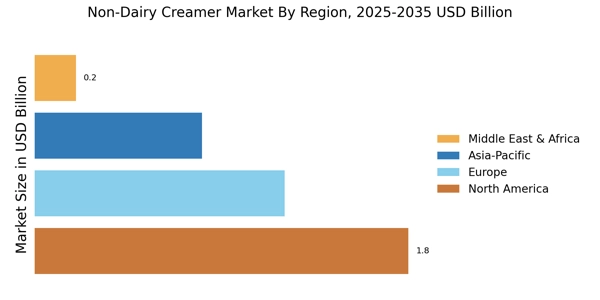Health-Conscious Consumer Trends
The rise of health-conscious consumer trends is significantly shaping the Non-dairy Creamer Market. As individuals become more aware of the nutritional content of their food and beverages, there is a marked shift towards products that offer health benefits. Non-dairy creamers, often perceived as lower in calories and fat compared to traditional creamers, are appealing to this demographic. Recent studies suggest that consumers are increasingly scrutinizing ingredient lists, favoring products with natural and organic components. This trend is likely to drive innovation within the Non-Dairy Creamer Market, as manufacturers strive to create healthier formulations that align with consumer preferences for clean labels and functional ingredients.
Convenience and On-the-Go Consumption
The trend towards convenience and on-the-go consumption is emerging as a significant driver for the Non-Dairy Creamer Market. As lifestyles become increasingly fast-paced, consumers are seeking products that offer ease of use without compromising on quality. Non-dairy creamers, available in single-serve packets and ready-to-use formats, cater to this demand effectively. Recent market analysis suggests that the convenience segment is growing, with a notable increase in sales of portable non-dairy creamers. This shift indicates that consumers are prioritizing products that fit seamlessly into their busy routines. Consequently, the Non-Dairy Creamer Market is likely to expand as manufacturers focus on developing convenient packaging and formulations that appeal to the modern consumer.
Rising Veganism and Plant-Based Diets
The increasing adoption of veganism and plant-based diets appears to be a pivotal driver for the Non-Dairy Creamer Market. As consumers become more health-conscious and environmentally aware, the demand for plant-based alternatives to traditional dairy products has surged. According to recent data, the plant-based food sector has experienced a compound annual growth rate of approximately 11% over the past few years. This trend is likely to continue, as more individuals seek non-dairy options that align with their dietary preferences. Non-dairy creamers, often made from almond, soy, or coconut, cater to this demographic, providing a suitable alternative for coffee and tea. The Non-Dairy Creamer Market is thus positioned to benefit from this shift, as manufacturers innovate to meet the evolving tastes and preferences of consumers.
Diverse Flavor Profiles and Customization
The demand for diverse flavor profiles and customization options is becoming a key driver in the Non-Dairy Creamer Market. Consumers are increasingly looking for unique and innovative flavors that enhance their beverage experience. This trend has prompted manufacturers to experiment with a variety of flavors, ranging from classic vanilla and hazelnut to more exotic options like caramel and mocha. Industry expert's indicates that flavored non-dairy creamers are gaining traction, with sales reflecting a growing preference for customized beverage solutions. As consumers seek to personalize their drinks, the Non-Dairy Creamer Market is likely to witness a surge in product offerings that cater to these evolving tastes, thereby fostering brand loyalty and repeat purchases.
Increased Awareness of Lactose Intolerance
The growing awareness of lactose intolerance among consumers is significantly influencing the Non-Dairy Creamer Market. It is estimated that a substantial portion of the population experiences some degree of lactose intolerance, leading to a heightened demand for lactose-free alternatives. Non-dairy creamers serve as an ideal solution for those who wish to enjoy creamy beverages without the discomfort associated with dairy consumption. Market data indicates that the lactose-free product segment has been expanding rapidly, with non-dairy creamers capturing a notable share of this growth. As awareness continues to spread, the Non-Dairy Creamer Market is likely to see an influx of new consumers seeking lactose-free options, thereby driving sales and product innovation.

















